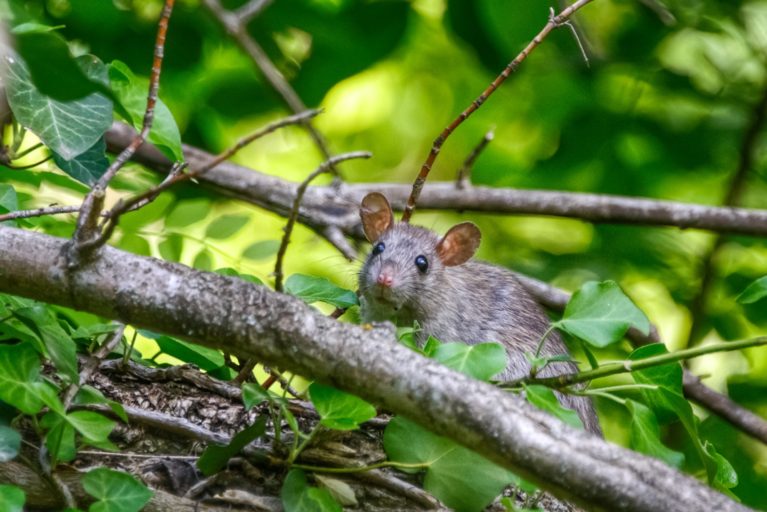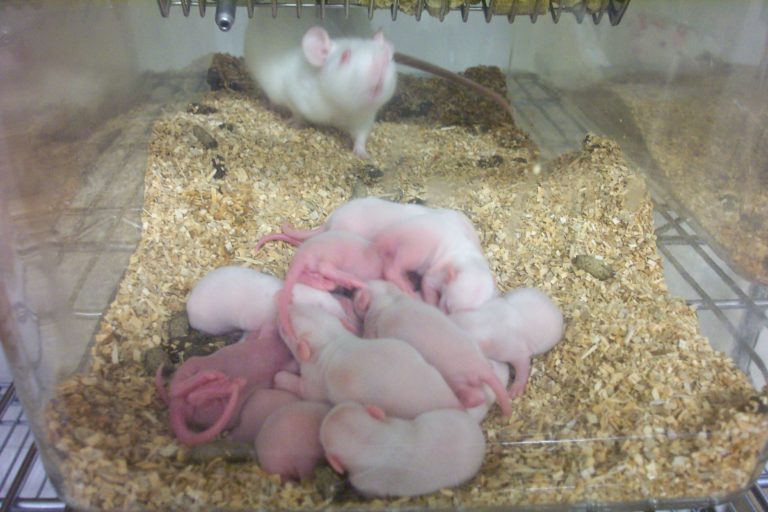Cautious rats – bait shy and trap shy – are a problem worldwide and researchers at the University of Liverpool, UK have been looking at other ways to attract rats into bait or trap boxes. So far the research has only been carried out on lab rats and still needs to be tested in the field. But the results, using recorded 50 kHz rat calls, show promise as a species-specific rat attractant.

So what’s so special about 50 kHz rat calls? It seems these are the frequency of prosocial rat calls – rat ‘happy sounds’ – first discovered by researchers tickling their tame lab rats.
“Communication signals that play an important role in survival, social coordination and/or reproductive success within a species are likely to be both species-specific and impede the development of resistance. One such signal that has the potential to attract rats is prosocial 50 kHz calls. These calls were discovered by Panksepp and Burgdorf when tickling laboratory rats, and have since been linked to positive emotions (affect) in this species. 50 kHz calls increase during play and sexual encounters, and their emission reduces aggression between conspecifics [‘conspecific’ = members of the same species]. Rats also appear to use these calls when searching for familiar conspecifics, with calls increasing when cage mates are separated, or when a lone rat is exposed to the scents of other rats from its colony. In open arenas, rats prefer to spend time near to a sound source playing 50 kHz calls.”
Bait boxes help protect pets and children from accidental poisoning – but they also discourage rats from interacting with bait. Sound lures could help to overcome that reluctance and, in countries like the UK where some of their ‘at risk’ species are also rodents (eg voles), a species-specific rat attractant could also help to prevent an unfortunate bycatch of small, endangered mammals.
“Rats, especially brown rats (alternatively called Norway rats) and black rats, are some of the greatest pests worldwide. They are a major threat to global food security, carry and transmit over 50 zoonotic diseases and pose a significant threat to many endangered species, particularly in island habitats. Control of pest species, particularly rats, relies mostly on the use of pesticides. Some of these pesticides are not species-specific and are bio-accumulative, passing up the food chain to affect higher trophic levels. As such, rat poisons are often presented within secure bait boxes to prevent access of pets and children. However, it is difficult to attract rats into the unfamiliar enclosed space of a bait box as rats avoid entering them. This avoidance, often termed behavioural resistance, also leads to rats avoiding other control devices that do not require poisons, such as traps.”

“To reduce these problems, we need to reduce the avoidance of control measures by rats and improve their species-specificity. Species-specific attractants targeted at pest species could provide an effective solution. Replication of cues or signals that a pest species normally relies on to locate attractive resources or social opportunities, or to avoid unsuitable conditions, has been identified as having particular potential for exploitation.”
Rat responses to these pro-social calls have previously been studied in open arenas, but the University of Liverpool researchers were interested in how they affected the rats’ responses to unfamiliar enclosed spaces.
“We test whether calls will attract rats to enter and spend time inside an unfamiliar enclosed space, such as the bait boxes very commonly used in current rat control. Because these pro-social calls are normally used for communication between familiar animals, responses may depend on recognition of the calling rat, which would negate their exploitation as a general attractant. To assess this, we test whether rats are attracted to calls from familiar and unfamiliar individuals. We also examine whether attraction is stronger towards 50 kHz calls from male or female rats, and whether this depends on the respondent’s sex.”
Sounds of rat movement were also included in the study, along with recordings of ‘white noise’ as an experimental control.
“We found that rats of both sexes were attracted to 50 kHz calls from either sex and to sounds of a rat moving around without vocalising. However, 50 kHz rat calls stimulated more consistent attraction than the sounds of rat movement alone. Whilst both types of rat sounds attracted rats to spend time in the general vicinity of a sound source, only 50 kHz calls attracted rats to spend time on top of boxes when sounds were played above the boxes. Notably, when listening rats were unfamiliar with sound donor rats, attraction to female 50 kHz calls was very strong while rat movement sounds stimulated only a weak attraction that was not significantly greater than response to white noise.”
Recorded calls not only got rats interested in the boxes – it also got them inside.
“50 kHz calls playing inside bait boxes stimulated both a greater number of entries and much more time spent inside bait boxes, despite the absence of any food baits in our tests. We found no sex specificity in the responses of rats to 50 kHz calls or rat movement sounds, although there was some evidence that 50 kHz calls from females were slightly more attractive than those from males.”
“The consistent attraction of unfamiliar rats of either sex to the 50 kHz calls emitted when rats are separated from same-sex cagemates, including attraction to enter and spend time inside bait boxes in the absence of attractive food, suggests that these calls could have potential application as an attractant lure in the context of rat pest control. However, further research will be needed to establish how far these findings translate to pest control settings. Our study involved laboratory rats tested in laboratory arenas. Little if anything is yet known about the production and use of 50 kHz calls among wild rats.”

The researchers have a number of suggestions for any future wild-rat trials, based on their lab-based findings.
“Calls most similar to those produced by unstressed wild rats are likely to be the most effective lure. The slightly stronger attraction to 50 kHz calls from females in our laboratory study suggests that female calls should be trialled as a priority in field experiments.”
“It is also possible that wild rats may be most effectively attracted using a combination of cues. A recent field study showed that synthesized ultrasonic calls imitating those of infant rats increased the number of female rats captured in trap boxes also baited with food and female rat soiled bedding. Removal of either the infant calls or the odour cue significantly reduced the number of rats captured. However, as infant calls were not tested alone, it is not known whether infant calls would attract rats into enclosed control points in the absence of bait.”
Prosocial calls may be more widely attractive to rats, than infant calls however.
“50 kHz prosocial calls may provide an advantage over infant calls in that rats of both sexes readily emit these calls and in turn are attracted to enter boxes playing these calls, providing a natural attractant that is much less likely to depend on the sex and breeding status of respondents.”
A sound lure is also more likely to work in situations where rats have plenty of food in their natural environment.
“An effective rat lure based on these communication signals would be particularly beneficial in situations where standard control measures using food baits are not successful in eradicating all individuals, typically because some rats will not enter bait or trap boxes, or to check that no individuals remain. In habitats where alternative food is readily available, food baits alone may be relatively ineffective at attracting rats into bait stations. Lures that can effectively entice rats into traps could have the additional benefit of reducing reliance on anticoagulant rodenticides, currently the predominant method used for rat control because rats are typically extremely wary of approaching traps.”
The full research article is freely available through the PLOS ONE website.
Testing the potential of 50 kHz rat calls as a species-specific rat attractant (2019)

